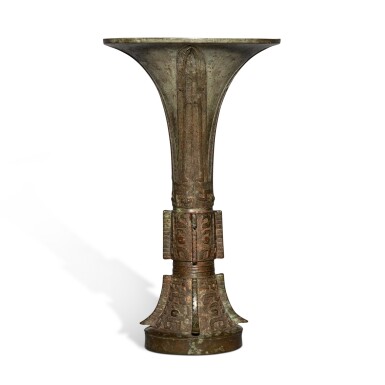Important Chinese Art
Important Chinese Art

Property from a French Family Collection
The Huan Fu Ding Gu, Late Shang dynasty | 商末 鴅父丁觚
Auction Closed
March 22, 08:01 PM GMT
Estimate
100,000 - 150,000 USD
Lot Details
Description
The Huan Fu Ding Gu
Late Shang dynasty
商末 鴅父丁觚
cast to the interior base with a three-character inscription reading Huan Fu Ding
銘文:
鴅父丁
Height 11½ in., 29.2 cm
American Private Collection.
Beurdeley & Cie, Paris, 8th October 1996.
French Private Collection, and thence by descent.
美國私人收藏
Beurdeley & Cie,巴黎,1996年10月8日
法國私人收藏,此後家族傳承
The Institute of Archaeology, Chinese Academy of Social Sciences, ed., Yinzhou jinwen jicheng [Compendium of Yin and Zhou bronze inscriptions], vol. 12, Beijing, 1984, no. 7119.
The Institute of Archaeology, Chinese Academy of Social Sciences, ed., Yinzhou jinwen jichengshiwen [Interpretations of the compendium of Yin and Zhou bronze inscriptions], vol. 4, Hong Kong, 2001, no. 7119.
Wang Xinyi, ed., Shangzhou tuxing wenzi bian [Dictionary of the pictograms from the Shang and Zhou dynasties], Beijing, 2007, no. 807, fig. 3.
Liu Yu et. al., Shangzhou jinwen zong zhulubiao [Comprehensive list of recorded Shang and Zhou bronze inscriptions], Beijing, 2008, no. 7766 (vessel recorded).
Wu Zhenfeng, Shang Zhou qingtong qi mingwen ji tuxiang jicheng [Compendium of important inscriptions and images of bronzes from the Shang and Zhou dynasties], vol. 18, Shanghai, 2012, no. 09582.
中國社會科學院考古研究所編,《殷周金文集成》,卷12,北京,1984年,編號7119
中國社會科學院考古研究所編,《殷周金文集成釋文》,卷4,香港,2001年,編號7119
王心怡編,《商周圖形文字編》,北京,2007年,編號807,圖3
劉雨等,《商周金文總著錄表》,北京,2008年,編號7766(器記錄)
吳鎮烽,《商周青銅器銘文暨圖像集成》,卷18,上海,2012年,編號09582
Remarkable for its tall, elegant shape and complex relief decoration highlighted by the neatly cast ground of leiwen spirals, this gu is an outstanding example of the late Shang dynasty bronze style, typical of the final stage of the development in Yinxu. Bronze gu, used as sacrificial wine receptacles, are known throughout the Shang dynasty, but it was in the late Shang period when bronze casting reached a new height that the vessel attained its final striking form. Gu, at first, were short and stout with simple taotie designs merely suggested by eyes amidst linear decoration, yet the refinement of shape and ornamentation steadily took place as the foundries’ technique gained in skill and experience. By the time the Shang capital had moved from Zhengzhou to Anyang in Henan province, gu of taller, more graceful proportions with intricate main and secondary taotie designs and other animal motifs had entered the foundries’ repertoire. The raised parts and the additions of pronounced flanges to the foot and middle sections, en vogue during the late Shang period, dramatically changed the vessel’s silhouette, giving it its distinctive sculptural appearance.
The inscription of the present vessel indicates the owner, who belonged to the Huan clan, made this precious ritual bronze for his father Ding. Several extant ritual bronzes from this clan have been recorded. See a late Shang dynasty ding with the same three-character inscription, reputedly excavated in Anyang, Henan province, now in the National Museum of China, Beijing, published in Zhongguo lishi bowuguan guankan [Bulletin of the museum of Chinese history], no. 4, Beijing, 1982, p. 96, fig. 3; a zhi inscribed with the same clan pictogram, preserved also in the National Museum of China, recorded in Yan Yiping, Jinwen zongji [Corpus of Bronze Inscriptions], Taipei, 1983, no. 6472; a you published in Liu Tizhi, Xiaojiaojingge jinwen taben [Rubbings of archaic bronze inscriptions in the Xiaojiaojingge], vol. 4, 1935, p. 15; and a further ding cast with four characters including the huan pictogram, attributed to late Shang or early Western Zhou dynasty, formerly in the collection of Pan Zuyin (1830-1890), now in the Shanghai Museum, Shanghai, illustrated in Chen Peifen, Xia Shang Zhou qingtongqi yanjiu [Study of archaic bronzes from Shang, Shang and Zhou dynasties], Xiashang vol. 1, Shanghai, 2004, pl. 57.
A bronze gu of similar design from the Palace Museum, Beijing, is illustrated in Palace Museum, ed., Gugong qingtongqi / Bronzes in the Palace Museum, Beijing, 1999, pl. 43; another in the Shanghai Museum, Shanghai, is published in op. cit., Xiashang vol. 2, 2004, pl. 116; one excavated from a Shang dynasty tomb in Chuqiu village, Hui county, Henan province in 1952, now in the Xinxiang Museum, Xinxiang city, is published in Wu Zhenfeng, Shang Zhou qingtong qi mingwen ji tuxiang jicheng [Compendium of important inscriptions and images of bronzes from the Shang and Zhou dynasties], vol. 17, Shanghai, 2012, no. 08888; and another from the Arthur M. Sackler Collection in the National Museum of Asian Art, Washington D.C., is discussed and illustrated in Robert W. Bagley, Shang Ritual Bronzes in the Arthur M. Sackler Collection, Washington, D.C., 1987, pl. 38.
See also several auctioned bronze gu of this type, including two sold in these rooms, the first inscribed with a three-character inscription indicating the bronze was made by a member of the Shan clan for his father Ding, formerly in the collections of both Cao Zaikui (1782-1852) and Fei Nianci (1855-1905), published extensively since the late 19th century, 23rd March 2022, lot 230; and the second from the collection of Julius Eberhardt, cast to the inside of the foot with a single clan pictogram, 17th September 2013, lot 1; and two further examples sold at Christie's New York, one formerly in the collection of Dr. Nathanael Wessén, inscribed with the clan sign of shi, 21st March 2019, 1510; and the second cast with an interesting inscription of Zi Long, 22nd March 2012, lot 1501.
